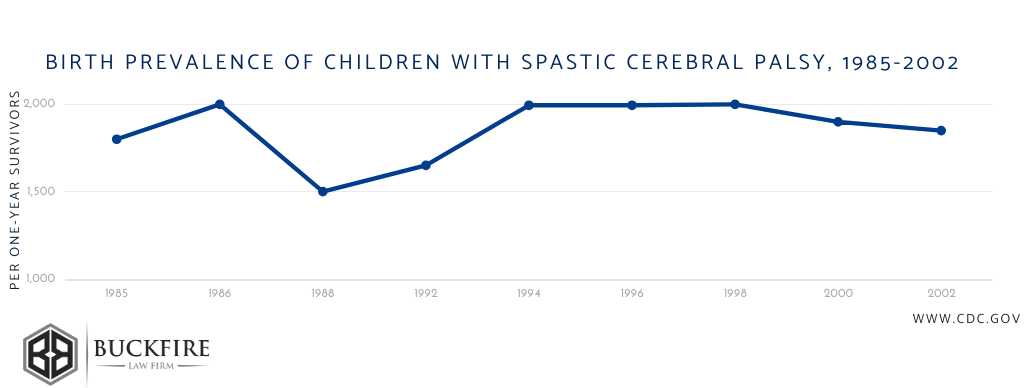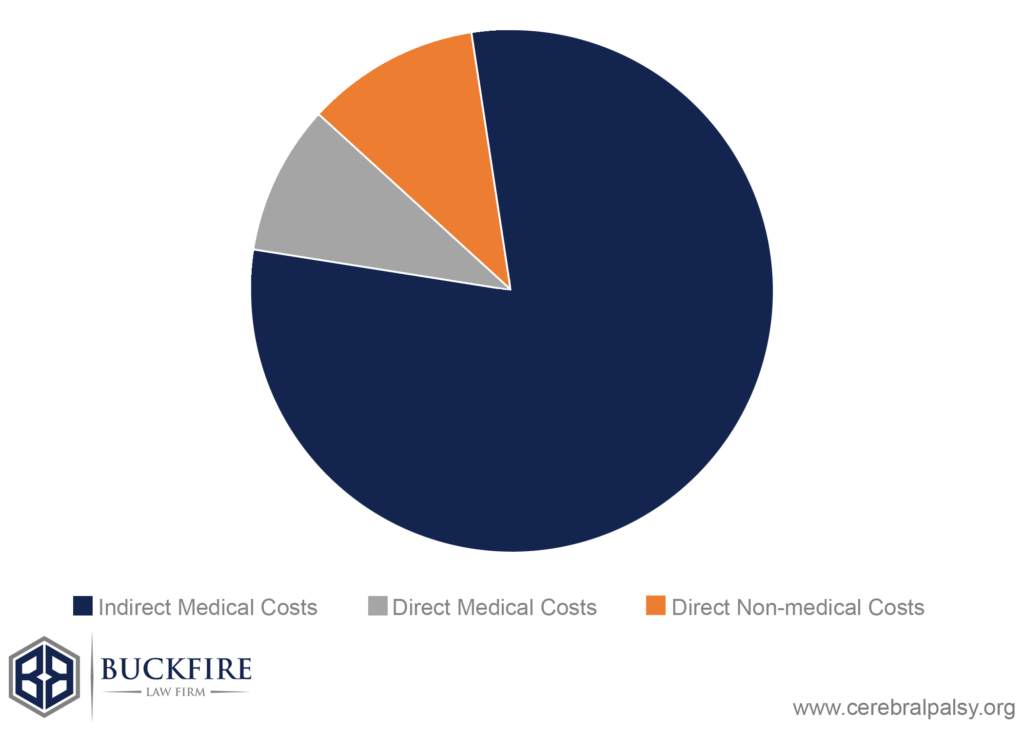A life care plan is a key element in every cerebral palsy lawsuit. These plans provide the economic loss projections over the lifetime of the child.
Birth injury lawyers experienced in handling these cases understand the importance and value of choosing the right expert witness for this role.
In many states, there are limits on the amount of money that can be awarded in a medical malpractice lawsuit. This includes cases for birth injuries, including cerebral palsy.
These artificial caps on damages are often for non-economic losses only, like pain and suffering Most state laws do not limit the total award of damages. As such, it is important to establish the economic losses of the child and family so they receive the maximum possible settlement.
The primary goal of a birth injury case is to provide the necessary economic means for the health, education, and safety for the lifetime of the child. Families need these funds to care for their special needs child and to ensure the child will receive the best possible care when they are no longer around.
- Who can be a life care planner?
- Organizations that certify life care planners
- How to find an expert life care planner
- What’s included in a cerebral palsy life care plan?
- Lifetime costs for cerebral palsy treatment
- Will health insurance cover treatment?
- Are life care plans admissible at trial?
What is a Life Care Plan?
A life care plan is an evidence-based report that sets for the current and future needs of and costs of a child born with cerebral palsy. The plan relies on information obtained from medical records, discussions with parents and doctors, and reliance on medical and scientific articles.
The purpose of the plan is to establish the likely medical, educational, housing, transportation, and other expenses over the child’s lifetime. A life care plan is an essential part of settlement discussions because it provides a basis for calculating the economic portion of damages.
In many cases, the lawyers on each side of the case will hire a life care planner to formulate a plan. The opposing life care planners often disagree on both the future needs of the child and the costs associated with providing the necessary services. Settlements often result from when there is a compromise of the two plans, but the amount must be enough to pay for child’s needs.
Who Can be a Life Care Planner?
Life care planners have a wide range of experience, but all must have an extensive medical background. Some planners are physicians and others have nursing backgrounds. Others are rehabilitation counselors and therapists. Any person with proper educational credentials, experience, and training can serve the role of a life care planner.
Attorneys should carefully review the credentials and training of any potential expert. This includes verifications of licenses, certifications, and even academic degrees. It could be very costly to pay for a life care plan and later discover a problem with the expert’s credentials.
Are there Organizations that Certify Life Care Planners?
There are many organizations that provide certification for life care planners. These organizations give the necessary education, training, materials, and testing to professionals.
Some noteworthy certifying organizations include:
- Certified Nurse Life Care Planner (CNLCP)
- American Association of Certified Nurse Life Care Planners (AANLCP)
- Case Management Society of America (CMSA)
- International Commission on Health Care Certification (ICHCC)
A certification demonstrates the expert has the education and training necessary to produce a reliable, accurate, and authoritative projection and estimate for the lifetime needs of the child.
However, certification is not required to provide this type of analysis in a lawsuit. Many physicians, including pediatricians and physical medicine and rehabilitation specialists, serve in this role because of their extensive research and medical knowledge.
What Experts Play Important Roles in Plan Creation?
The plan is created through the reliance on medical records and the gathering of additional information. There are many specialists that provide a key role in the creation of the plan.
The life care planner will often personally meet with or interview a variety of experts to formulate different aspects of the plan. Because the plan must be comprehensive and cover all aspects of the child’s life from infancy into adulthood, the necessary experts include a:
- Pediatrician
- Physical Medicine and Rehabilitation doctor
- Neurologist
- Occupational Therapist (OT)
- Physical Therapist (PT)
- Pharmacist or pharmacy company
- Special education needs expert
- Home design, modification, and building expert
- Vehicle modification expert
- Economist
This may seem like very involved and quite frankly it is a major project. Attention to every detail is essential so it is accepted as reliable by the defendant as well as the court.
How do I Find an Expert Life Care Planner?
Attorneys can find a life care planner through a number of means. Many times, a recommendation from a colleague can identify the expert. These referrals are often most reliable because it eliminates the unknown element and increases the chance of the expert’s reliability.
A great way to find a qualified life care planner is to search medical literature and authoritative articles to identify leaders in the field. These individuals may be more immune to attacks on their qualifications than those with no published literature or academic accomplishments.
Another source for potential experts is the website of the certifying organization. Many have online listings of certified life care planners in each state. A lawyer can review those listings and contact individuals to ascertain their interest and availability for a specific case.
There are also expert witness services that provide lawyers with names and contact information for an individual. There is usually a cost associated with these referrals. However, many services provide curriculum vitaes for multiple experts and the attorney can interview them to choose the person best suited for the particular case. In addition, these services often have access to life care planners that cannot be found through other avenues.
In addition, many experts list their credentials and availability on expert witness websites. Attorneys can browse these websites and contact the life care planner directly. All fees are paid directly to the witness without the “finder fees” associated with traditional expert services.
What is Included in a Cerebral Palsy Life Care Plan?
List of Materials Reviewed
The care planner will list the records and other materials reviewed in connection with the report. This will include all educational records, pre-school assessments, medical records, videos, equipment used, and all other items reviewed in connection with the preparation of the report. This is important to establish the foundation for opinions in the report.
Summary of Materials Reviewed
The care planner will do a narrative summary of records. This often starts with a detailed analysis of the labor and delivery records and includes the subsequent hospitalization. The summary will then outline the medical findings and treatment from birth until the preparation of the report. This includes the different diagnosis from specialists, medications, radiology findings, and all essential information from the records reviewed.
There are different types of cerebral palsy. The summary should identify the specific diagnosis for the subject child and the degree of that condition. This will provide an important basis for the future care of the child and the recommendations made in the life care plan.
This summary may include recommendations of physicians and therapists for future treatment, as well as educational plans and goals. It should provide a detailed picture of the child’s health from the time of birth through the present date.
Current Status
The child’s current health status is an essential part of the report. A summary should include information about the residence of the child, including the layout and potential future barriers to the child’s ability to live and grow in that home environment.
Information about the current medications and a listing of all medical specialists is listed. This list should identify the name of each medical provider, the area of specialist, the frequency of visits, and the type of treatment currently being provided. In addition, a list of all medications and current therapies will be outlined in the report.
Many life care planners personally meet with the family and child to best understand the current living conditions. These interviews can provide insightful information that cannot be gleaned from medical records. Observations of family members and descriptions of daily activities are also helpful in understanding the difficulties and burdens encountered by the family every day.
The Lifetime Costs for Cerebral Palsy Treatment
This is the section of the report that outlines in detail each specific cerebral palsy treatment needed over the child’s lifetime. It also identifies the cost for each item or service for specific time periods. Essentially, it is the very reason the life care plan was created for the lawsuit.
The report will breakdown each service, treatment, medication, and type of necessary equipment either on an annual basis or by age grouping. For example, a new piece of equipment may be needed on a yearly basis from age one to five but then one piece can be used from age six to twelve. The same is true for therapies, support care, and other needs.
A cost per year summary is determined on an annual basis and then totaled for the lifetime cost. In addition, the planner will set forth the specific requirements and costs for each annual period. The line chart below shows the birth prevalence of children with cerebral palsy between 1985-2002.
The main components of the plan include the following categories:
Routine Medical Care: A listing of the regular visits and evaluations by medical specialists. It lists the area of specialty, name of provider, frequency of visit, and annual cost.
For example, many children with cerebral palsy need evaluations by multiple specialists for routine visits several times per years. This can include a pediatrician, PM&R specialist, audiologist, ophthalmologist, dietician and gastroenterologist. Consultations with an orthopedic surgeon may be required on a less frequent basis, but still must be included in the plan.
Counseling services for the child and parents are also necessary. These services help the family deal with adjustment issues in caring for a child with special needs. This counseling is often in addition to services provided by the government and the school district.
Diagnostics: Regular diagnostics are import to prevent future complications in a child with cerebral palsy. Annual tests are an essential part of the treatment and monitoring protocol. These tests can include bloodwork, labs, swallow studies, radiology, and other diagnostics.
Procedures: The child may require multiple procedures over a lifetime. Many procedures are necessary for the first four years of life. These can include a gastrostomy tube placement which can cost in excess of $18,000 and an Inracathecal Baclofen Pump costing over $46,000 for the procedure, including surgeon fee, equipment, and hospital charges.
In addition, many patients need a MicKey Button for nutrition, fluid and medication administration. These need replacement up to four times per year during infancy.
Medications: The costs of prescription drugs, vitamins, and other supplements is factored into the plan. Many expenses are not covered by health insurance or have sizable co-pays.
Therapy: Children born with cerebral palsy require multiple types of therapy for both care and rehabilitation over a lifetime. These include the following therapies:
- Physical Therapy to promote strength and endurance and to prevent complications
- Occupational Therapy to promote independence in activities of daily living and to develop a home exercise program
- Speech Therapy to promote oro-motor strength and communication
- Vision Therapy to improve vision
Although many therapies are provided through the school system, additional therapies are often needed to augment school them to ensure the child can reach the maximum potential.
Equipment & Supplies: Durable medical equipment and supplies are a major expense over the child’s lifetime. Examples of equipment needed for a special needs child includes:
- Special needs stroller
- Pediatric wheelchair
- Special needs car seat
- Portable ramps
- Syringes
- Formula
- Feeding bags with tubing
- Feeding pumps
- Extension tubing
- MicKey Button
- Positioning devices
- Specialty beds and mattresses
- Hoyer lifts and slings
- Bath seats
- Hand held showers
- Shower chairs
- Gait trainers
- Hand splints
- Glasses
- Hearing aids
- Diapers
- Simulation toys
Many pieces of equipment require replacement on a regular basis and require upgrades to new sizes for the physical growth of the child. Maintenance is also needed for many supplies.
Support Care: During school age years, there are often recommendations for a Licensed Practical Nurse to provide skilled assistance with activities of daily living. Depending on the geographic locale, the hourly rates can be as much as $50 per hour.
In addition, case management support to ensure access to resources and continuity of care is needed. The annual cost of these combined services can exceed $ 80,000 per year from through age twenty-one. Additional services may be necessary for a specific child’s needs.
Transportation: Specialty vehicles, like a modified van with a lift, are required for wheelchair bound patients. An existing van can be modified or the family may need to purchase a new vehicle for mobility and accessibility to the community. Vans may need to be replaced every five to seven years depending on usage and the condition of the vehicle.
Housing: A family residence will likely need to be modified for wheelchair accessibility and other accommodations. Home modifications of doorways and hallways, ramps, lowered counters, roll-in showers, and even an elevator may be necessary to provide adequate housing.
Does Health Insurance Cover These Payments?
Defendants may claim that many of the itemized expenses in the life care plan will be covered by health insurance or through government programs. However, insurers and government programs, including Medicaid programs, often assert liens on medical malpractice settlements that require the insured to re-pay any paid benefits.
And, with the uncertain future of government mandated insurance it is difficult to project if the child’s needs will be met through insurance programs. Quite simply, the lawsuit goal of providing care for the child’s lifetime must have a reasonable degree of certainty.
Changes in legislation and court cases can change benefits with every administration. For these reasons, it is important to secure the necessary funds in advance to provide for these needs.
The pie chart below shows the total costs associated with treatment, with indirect medical costs accounting for more than 75% of all costs associated with the treatment of cerebral palsy.
Are Life Care Plans Admissible at Trial?
The life care plan must not only be comprehensive, but it must also satisfy the evidentiary requirements to be admissible into evidence at trial. The majority of birth injury lawsuits settle out of court, but the plan must be drafted with the expectation of a trial.
A loosely created plan may be stricken by the court and not allowed to be presented to the jury at trial. This would be a devastating court decision to any litigant because the biggest element of claimed damages would not be considered in determining the jury verdict.
Defense attorneys often challenge plans by arguing they were not based upon established methods. The claim is the findings are unreliable and inadmissible at trial.
Many states have their own evidentiary rules and requirements for the admissibility of expert witness testimony. However, the main case in the United States is Daubert v Merrell Dow Pharmaceuticals, Inc., 509 U.S. 579 (1993). Judges rely on this case and its progeny in determining whether an expert witness can testify on a substantive issue in a case.
In cases where the plaintiff offers a life care planner as an expert witness, the defendant may challenge the admissibility of both the expert and the opinions at trial.
The most common basis for these Daubert type challenges includes the:
- Qualifications of the expert to provide the opinions
- Failure of the life care planner to meet or discuss the issues with treating physicians
- Absence of supporting information in the medical and educational records
- Insufficiency medical and scientific literature to support the opinions
- Improper basis for providing future needs and expenses of the child
- Speculative nature of the findings and opinions
In addition, the dollar projections in the report must have data to support all charges and costs. Most reports provide references justify the itemization of expenses. Sources can include health insurance payment schedules, pharmacy prescription costs, and school tuition prices.
It is essential that attorneys take use the same scrutiny for their life care planner as they do for their other medical experts, like neonatologists, neurologists, and obstetricians. A court’s decision to exclude an expert can have a devastating impact on the case.
Legal Issues & Requirements
Most children with cerebral palsy are eligible for many types of government benefits and education. For example, The Individuals with Disabilities Education Act (IDEA) is a federal law mandated in every state and county in the United States. The law entitles handicapped children to appropriate education in the least restrictive environment.
IDEA services including family counseling and training, special education, speech pathology, audiology, occupational and physical therapy, psychological services, and more.
Many states and counties have government programs that provide additional assistance to both the family and child. The plan should discuss these programs and the availability of services to the child that is the subject of the report.
The End Result
The final report should provide a proper basis for lifetime cost to care for a child with cerebral palsy. The defendant will likely produce its own expert witness report that will univariably have a lifetime cost substantially lower than the report proffered by the plaintiff.
Defense counsel will undoubtedly attack the opinions and conclusions of the expert hired by the plaintiff’s attorney. It is essential to choose a life care planner that can withstand the scrutiny of a skilled birth injury lawyer. The plaintiff’s lawyer should expect a court challenge and be prepared in advance to thwart the possible exclusion of that witness.
In the end, a well-crafted report from a qualified witness will bolster the case and help ensure that both the child and family receive the needed compensation in the lawsuit.
(Main)
- 29000 Inkster Road
Suite 150
Southfield, MI 48034
- Phone: (248) 595-7544
- 19 Clifford St.
Suite 805 Merchants Row
Detroit, MI 48226
- Phone: (313) 992-8281
(Woodward Address)
- 1001 Woodward Ave.
Suite 505
Detroit, MI 48226
- Phone: (313) 777-8482
- 343 S. Main Street
#206
Ann Arbor, MI 48104
- Phone: (734) 888-3003
- 51424 Van Dyke Ave
#3
Shelby Township, MI 48316
- Phone: (586) 250-2626
- 432 N. Saginaw Street
Suite 413
Flint, MI 48502
- Phone: (810) 818-8182








